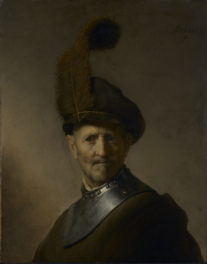At first glance, Gerard ter Borch’s painting The Music Lesson seems easy to figure out. In this 17th-century Dutch work, a man gives a lute lesson to an elegantly-dressed young woman, while a small dog sleeps on a nearby chair. But, as with most things in art, not everything is as it seems.
Upon closer inspection, one can find Ter Borch’s delightfully subtle motifs suggesting love, desire, and even love-making in this music lesson. These were common themes for Dutch “genre” paintings, or scenes from everyday life, where music-making was a metaphor for love. Most of Ter Borch’s symbolism would have been familiar to 17th-century middle and upper class audiences, but it’ll take some investigating for us modern viewers to find and recognize all of these clues.

The Music Lesson with salient details marked in red. On the left side we find a bass viol, a sleeping dog, and a foot warmer. On the right side looms a bed with open curtains.
Music Teacher, or Maestro of Love?
Let’s begin with the people. The young woman, modeled after Ter Borch’s half-sister Gesina, plays a two-headed French lute, and her open mouth might mean she’s singing along. Her teacher stands next to her, keeping time with his hand. Notice that his gaze is somewhat ambiguous, and it’s unclear whether he’s looking at the young woman’s sheet music or if he’s preoccupied with her pretty face.
Notice also that, despite being indoors, he wears his hat, suggesting that he’s a visitor in her home. They have no chaperone and the door is almost, almost closed.
Faithful Fido Takes a Break
But, is the musical pair actually alone? A dog also dozes in the room.
Dogs tend to symbolize loyalty and fidelity. Interestingly, the dog in this painting sleeps through the music, a subtle way of saying, “fidelity sleeps.” Perhaps, then, this lesson is a seduction.

Sleeping dog, hidden foot warmer.
Feet—and Hearts—Afire
Look closely at the bottom left corner of the painting. Hiding there is a small, wooden box. This is a foot warmer (a vessel that held hot coals), and, you might guess, is yet another symbol of desire. Fireplaces were often seen as representative of the “fires of love” in paintings featuring couples, and this small foot warmer is no different.
Solo or Duet?
Now let’s take a look at the instruments. A cello-like instrument, called a bass viol, lies on the table near the door. Dutch music was rarely performed with a single instrument. The teacher might pick up the bass viol at any moment to accompany the young woman in her music-making. This can be interpreted as not only alluding to a potential musical duet, but may also hint at a “duet” of sorts between the bedsheets.
Well, That’s Convenient
The most-suggestive object in the room is in the back right corner, where a large, magnificently draped bed looms in the background. The curtains on the bed are drawn open, indicating that this couple might very well be found coupling there after the music lesson. One of the artist’s favorite motifs, it too alludes to love, and the outcome of their duet.
Gerard ter Borch liked to keep his genre paintings ambiguous in meaning, allowing viewers to apply their own interpretations. While it may take 21st-century viewers some sleuthing to understand all of symbols in these types of genre paintings, the subtle (and sometimes not-so-subtle!) themes of love and desire were fairly common in 17th-century Dutch art.





Comments on this post are now closed.